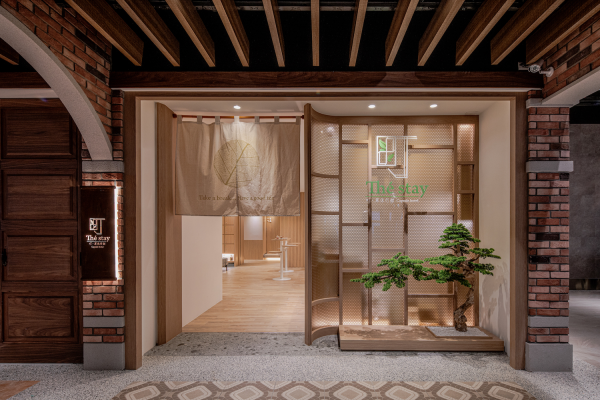









Image Credit : CHENG PU Interior Design Ltd

Project Overview
The Stay is the first 24-hour airport hotel in Taiwan, located in Terminal 2 at Taiwan Taoyuan International Airport. It adopts a hostel format to maximize resting area within limited spaces. Situated right next to the Dadaocheng district replica in the airport, the design is inspired by the tea industry. Thé is “tea” in French, and the phonetic pronunciation in Taiwanese. From spatial design to accommodation experiences, tea culture is included.
Project Commissioner
Project Creator
Project Brief
Many red-eye flights operate in late nights or early mornings. To take mass transportation, many travelers wait early at the airport. Even taking the last train, it is still a long while before boarding. Therefore, many travelers sit or lie down at the lobby. It’s an unpleasant and inconvenient experience. Other hotels around the airport sell their rooms by night, so they do not serve these passengers who only need short breaks.
We understand these travelers, such as students or backpackers, are sensitive to price, and they need a place to refresh themselves. Therefore, we sell spots by hours to travelers from other parts of Taiwan waiting for red-eye flights or early-morning flights. They can also stay overnight for a good rest. It’s a new and convenient option.
The airport is also the first stop to learn about Taiwan. We use Taiwanese tea, its fragrance, and its flavor to connect with Taiwan, and create lasting memories with experiences.
Project Need
Basic tone and color are both from tea. We use wooden texture, lines, shapes, and materials as design inspirations, and transform winding lines in tea farms into grids and matrixes. Each unit space is inspired by teahouse ridges, and each room is named after tea-making processes or tea names. Marks are decorated with tea ceremony tools. The front gate façade uses curved lines to create a shrinking entrance. It is inspired by Japanese tea master Sen-no-Rikyū. By going through small and narrow tearoom entrance, he stays humble to the tea ceremony. As the entrance is only shrunk visually, glasses are added to the woven rattan façade to ensure privacy and fireproof feature. We continue to balance between aesthetic value and practical purposes.
A tea room is placed at public area, and replace traditional seats with modern bar tables. With a lot of foot traffic at the airport, tea culture experiences need to be faster as well. Consumers can bring their tea bags home or enjoy at the tea room. Glass tea sets can show the change in tea leaves, and introduce tea culture to passengers.
Design Challenge
After observing beds and spaces in hostels and capsule hotels, we make the following adjustments:
1. Each bed is equipped with a small table, makeup mirror and fire sprinkler, so each unit is as complete and safe as a room.
2. Expand spaces to accommodate personal luggage beside mattresses for more privacy and order.
3. Each opening and ladder are placed intermittently to avoid disturbances.
4. There are also family rooms with two double beds for families or groups of friends.
5. Each single bed is designed with curtains for privacy. As ropes may constitute safety concerns for children, family rooms are designed with blinds.
6. Each room is equipped with luggage space and locks for more convenience.
7. Ladder handrails are extended towards walls to increase safety. Each handrail is 4.2 centimeters wide to accommodate a wider variety of travelers and support the structure.
Sustainability
To offer a full tea culture experience, we not only translate the image into tangible objects, designs and flavors, but also increase access to tea. Tea fragrance and tea pillows are provided for calmness. These sensory experiences create intangible but long-lasting memories.
Limited by space and site, we design the precious public area as a tea room to show our hospitality in Taiwan, and to engage with travelers in the hostel.
We also enhance ladders in the hostel. While ladders in most capsule hotels are thin, slippery, and difficult to use when coming down, our ladders get narrower to the top. In our experiments, it is easier to use in both directions.
Tags
Interior Design - International Hospitality - Stay
Open to all international projects this award celebrates innovative and creative building interiors, with consideration given to space creation and planning, furnishings, finishes, aesthetic presentation and functionality. Consideration also given to space allocation, traffic flow, building services, lighting, fixtures, flooring, colours, furnishings and surface finishes.
More Details

